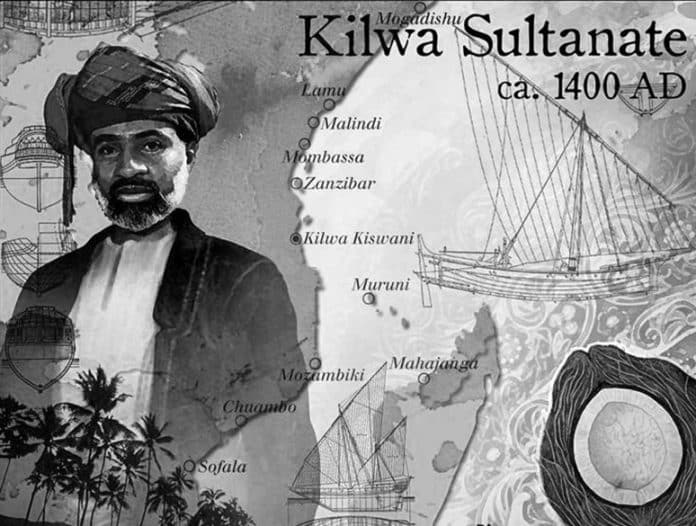Kilwa Sultanate – History, Rulers, Society, Economy, Fall and More!
Kilwa was a sultanate on the island of present-day Tanzania, whose authority stretched the whole Swahili Coast at its height. Legend has it that Ali ibn al-Hassan Shiraz, a prince from Iran founded the sultanate in the 10th century. The sultanate was under the rule of his family until 1277. Abu Moaheb’s family took over until 1505 when the Portuguese invaded and overthrew them. The sultanate had been divided into tiny states by 1513; most became territories of the Sultan of Oman.
Background of the Sultanate of Kilwa
Kilwa’s history starts about 960–1000 AD. Ali son of al-Hassan Shirazi was one among the sultan of Shiraz, Persia’s 7 sons whose mother was a slave from Abyssinia according to legend. After the death of his father, Ali’s brothers drove him out of the inheritance. Ali ibn al-Hassan sailed out of Hormuz, with a tiny group of followers and his household to Mogadishu, the coast of East Africa’s largest business center. However, Ali never managed to settle with the Somali elite in the city and was banished from here too.
Moving along the coast of Africa, it is said that Ali purchased Kilwa Kisiwani from its inhabitants, the local Bantu. According to a chronicle (Strong, 1895), King ‘Almuli’ of the Bantu mainland was the original owner of Kilwa with a tiny land bridge connecting it to the mainland appearing in low tide. Ali ibn al-Hassan agreed with the king to buy Kilwa for colored cloth covering the island’s circumference. The king changed his mind later and attempted to t reclaim it making the Persians dig up the connecting bridge, consequently, Kilwa became an island.
Instead of being a literal recalling of circumstances, this mythical history strives to legitimate the empire through connections to Islam. Horton and Middleman noted that the rise from a royal Islamic family as well as a slave from Abyssinian (Ethiopian) describes why the monarch were both black with a royal Muslim lineage; the granting of fabric to the sultan made him mannerly with his daughter becoming ready for marriage.
Kilwa’s strategic location made it the best center for trade in East Africa compared to Mogadishu. It soon started to catch the eye of various immigrants and merchants from further north, such as Arabia and Persia. Within some years, the town became big enough to asset up a satellite village near Mafia Island.
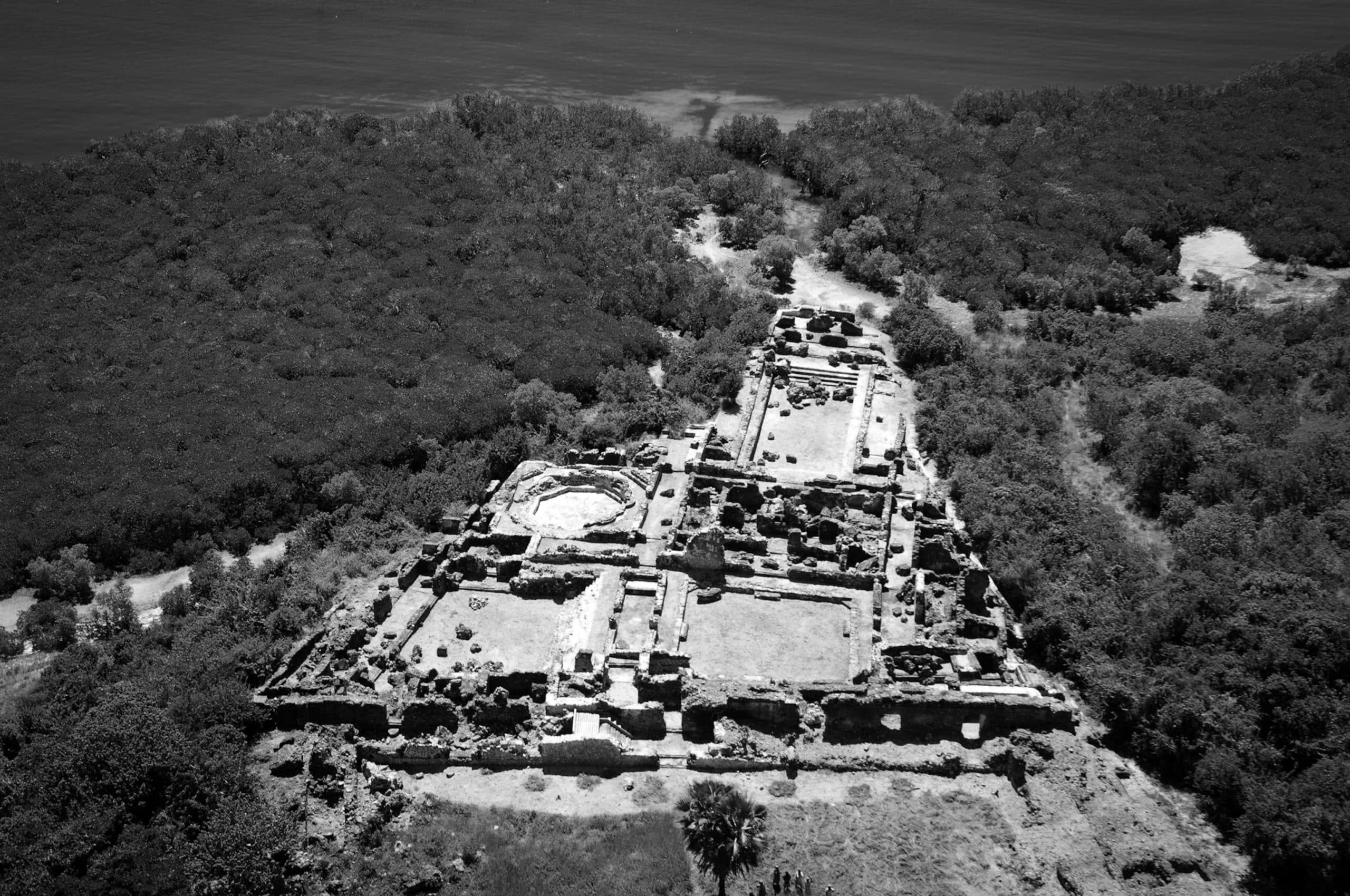
The emergence of Kilwa as a business center challenged Mogadishu’s former dominance over the coast of East Africa. Suleiman Hassan, Ali’s 9th successor as well as Kilwa’s 12th monarch c. 1178–1195, fought for control of the city of Sofala in the south from the Mogadishans. Opulent Sofala was a principal point of entry in the trade in ivory and gold with remote Monomatapa and Great Zimbabwe. Acquiring Sofala introduced immense revenue from gold to the Sultans in Kilwa, allowing them to fund their expansion as well as broaden their powers across the coast of East Africa.
In the 15th century during the peak of its power, the Kilwa Sultanate possessed or alleged leadership over cities in the mainland including Inhambane, Malindi, Sofala including the island-nations of Zanzibar, Pemba, Mafia, Mombasa, Mozambique, and Comoro (including various tiny areas) – essentially what today is known as the “Swahili Coast”.
Furthermore, Kilwa purported leadership across the channel to the various tiny trading areas scattered on Madagascar’s coast (known in Arabic as Island of the Moon by then). Kilwa’s authority was challenged by the sovereign Somali city-states including Barawa (a self-governing aristocratic state) as well as Mogadishu (a former dominant town, Kilwa’s biggest rival) in the north. In the south, Kilwa’s boundary extended to Cape Corrientes, underneath which merchant ships never dared to sail.
The Sultan, stood alone at the leadership of the hierarchy, yet the Kilwa Sultanate wasn’t a centralized state. The sultanate was a confederation of business towns, each having own merchant communities, trade connections, and internal elite. The Sultan had the authority to appoint an overseer or governor, yet even his power was inconsistent – in some areas (e.g. precincts such as the Island of Mozambique) he was the real governor having the Sultan’s name, while in more entrenched towns such as Sofala, his authority was more limited, similar to the city’s ambassador than its governor.
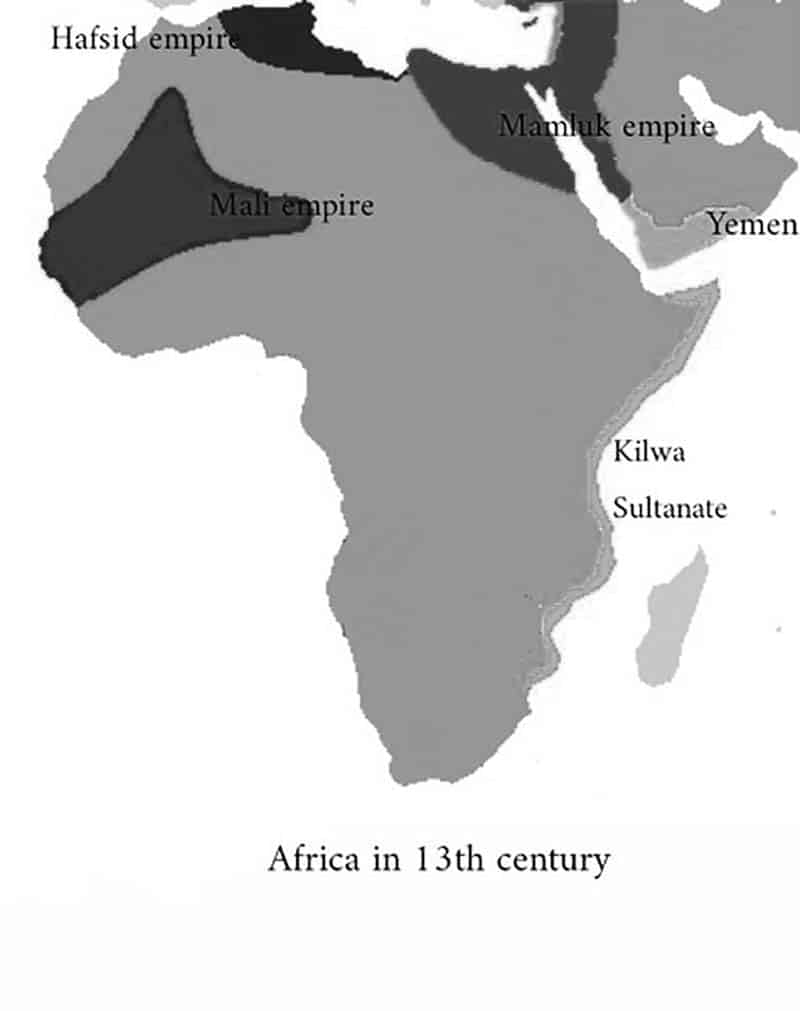
Community and Economy
Regardless of its Persian origin, transformation of indigenous Bantu inhabitants and extensive inter-marriage including later Arab incoming, made the Kilwa Sultanate a real melting pot, ethnically not distinguishable from the mainland. A blending of Bantu and Perso-Arab cultures is responsible for creating a particular culture in East Africa and language known as Swahili today (meaning, coast dwellers). Nevertheless, Kilwa Muslims (disregarding their ethnicity) would regularly call themselves generally Arabs or Shirazi, and the Bantu people on the mainland who had not converted as Khaffirs (‘infidels’) or Zanj.
The Sultanate of Kilwa was almost fully dependent on outside commerce. To put it well, it was a collection of modern settlements, and little or no farming was done within the sultanate boundaries. Grains mostly rice and millet, meats including poultry and cattle, as well as other basic supplies to provide food for the huge population in the city were bought from the remote Bantu people.
Kilwan coastal traders promoted the development of trading centers in the highlands dominated by Bantu what is t Tanzania, Kenya, Zimbabwe, and Mozambique today. Middlemen trading was the Kilwan way of living including, importing goods from factories (fabric, etc.) from India and Arabia, for swapping highland trading centers to get agricultural commodities (meats, grain,) produced by Bantu for their livelihood and valuable raw materials (ivory, gold, etc.) for export to Asia.
The coconut palm tree was excluded. Cultivated on the coast, Kilwan life depended heavily on the coconut palm in every way – apart from being a fruit, additionally for waving, timber, and. merchant ships from Kilwa – including the huge lateen-rigged dhows which operated the open oceans as well as the tiny zambucs for local movement – were always built using the wood trunks of coconut palm after splitting, coconut leaf matting was for making sails and coconut coir for holding the ships together.
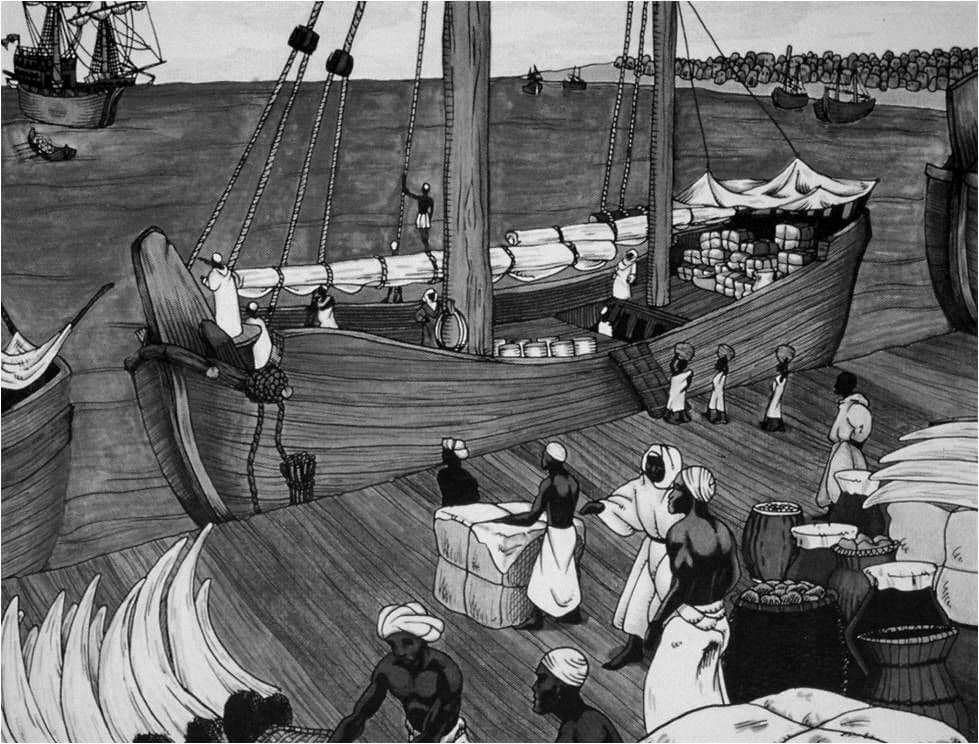
The sultanate of Kilwa Sultanate traded extensively with Persia, Arabia, and beyond the Indian Ocean, up to India. Ships from Kilwa relied on seasonal monsoon winds for sailing across to India during the summer, and for coming back to Africa during winter. Kilwan pilots were known for extraordinary accuracy during sailing. The Portuguese admired their navigational instruments, especially their latitude staves that they thought to be superior compared to theirs.
Nevertheless, the Kilwan ships sewn with coir weren’t seaworthy enough to withstand the treacherous waters as well as capricious violent gusts near Cape Corrientes, the whole southern region rarely received merchants from Kilwa. Inhambane, a southernmost settlement was considered part of Kilwa’s trading empire.
Decline and Downfall
As years passed, the Sultans of Kilwa started becoming possessed by their energetic ministers (emirs and viziers), who acted as kingmakers, as well as de facto monarchs, and periodically tried to impose themselves (or any of their relatives) on the throne, challenging the royal dynasty. Emir Muhammad Kiwabi was the most successful, who led Kilwa for about 20 years through various sultans, such as himself at one time.
Emir Muhammad fought regular battles with Hassan ibn Suleiman, with his nephew, (son of a former vizier) throughout his prolonged ‘reign’. Muhammad had attempted to enthrone Hassan as sultan various times but faced terrible resistance from the people of Kilwa. Finally, Emir Muhammad pronounced that, Kilwa’s sultans must always be from the royal family, not from viziers’ families for the good of civic peace and constitutional propriety. Muhammad stuck to that line until the end, frustrating Hassan’s ambitions.
In 1495, Emir Muhammad installed Prince al-Fudail son of Suleiman who was the last sultan before his death. Emir Ibrahim (Abraemo in Goes, Mir Habrahemo in Barros) succeeded Muhammad’s post, assisted Al-Fudail to suppress Hassan’s ambitions for good in a fierce battle outside Kilwa. However, soon after this battle, it is said Emir Ibrahim betrayed and killed Sultan al-Fudail.
Instead of declaring himself sultan, Ibrahim just usurped power as emir and declared exercising power in place of Sultan Suleiman ibn Muhammad’s son from the old royal kingdom. Being that none had heard or seen this absentee prince for years made leadership convenient for Emir Ibrahim.
Emir Ibrahim’s takeover was shocked Kilwa and the subordinate cities too. Emir Muhammad had (tardily) acknowledged the benefit of constitutional propriety for a peaceful Kilwa Sultanate. The murderous takeover of Emir Ibrahim’ had run heavy-handed over it. Many local governors in Kilwa subordinate cities, most of who were relatives or had positions thanks to Emir Muhammad as well as the royal kingdom rejected acknowledging Emir Ibrahim’s overthrow and started planning to create independence in their cities or states. Emir Ibrahim’s command probably just covered Kilwa city and perhaps the Island of Mozambique.
This was somewhat the condition of the sultanate of Kilwa by the arrival of the Portuguese.
Pêro da Covilhã, a scout from Portugal had traveled across the sultanate of Kilwa in 1489–90 under the guise of an Arab merchant, and toured the ports of Kilwa, Sofala, and Malindi, and sent his report after scouting back to Lisbon, portraying in detail the status of the Kilwa Sultanate. The first ships from Portugal, led by Vasco da Gama, going to India, arrived in the sultanate by 1497. Da Gama contacted the Kilwa subordinates of Malindi, Mombasa, and Mozambique, trying to get their partnership as staging posts for the India Armadas from Portugal.
The second India Armada from Portugal, led by Pedro Álvares Cabral in 1500, arrived at Kilwa and tried to negotiate a business and partnership agreement with Emir Ibrahim. However, Emir equivocated without reaching an agreement.
The 4th Armada led by Vasco da Gama returned in 1502 armed to the teeth unwilling to accept resistance. After securing individual treaties with Mozambique, Malindi, as well as the very important Sofala, a menacing fleet from the Portuguese came to make an impact on Kilwa and wrested a considerable tribute from the Emir.
There were speculations whether Emir Ibrahim lost a golden chance to regain his wealth, if an agreement with Cabral had been signed in 1500, he had the potential to secure the help of the Portuguese navy to bring back the semi-autonomous subordinates under his command. At least Muhammad son of Rukn ad-Din (Muhammad Arcone to the Portuguese) a nobleman in Kilwa, recommended Emir Ibrahim’s alliance with Portugal (and for his trouble, was handed over to the Portuguese as a hostage by the Emir, he refused ransom to save him back –exposing him to da Gama’s wrath).
Consequently, one subordinate after another permanently broke away from the sultanate with Portuguese assistance. The monarch of Malindi became the first to cooperate with the Portuguese, in 1497, allied (mainly against Mombasa). After the overthrow of Emir Ibrahim, persuading the new monarch, Sheikh Isuf of Sofala (known as Çufe in Goes, Yçuf in Barros, apparently late Emir Muhammad’s nephew ) to break away. Sheikh Isuf signed an agreement with the Portuguese in 1502, subsequently followed it up with the Portuguese construction of a factory including a fort in Sofala by 1505.
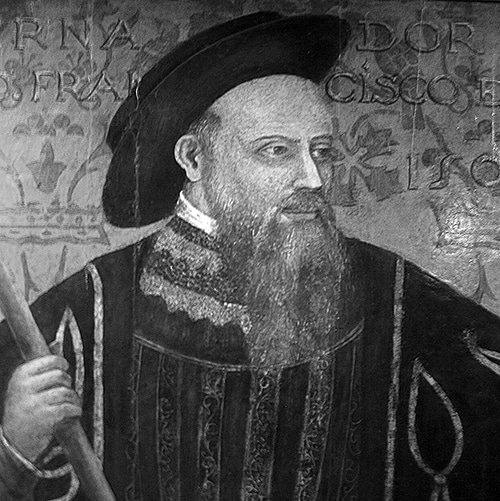
In the same year, Francisco de Almeida landed with his fleet on the harbor of Kilwa, with 500 soldiers from Portugal to chase Emir Ibrahim away from the city. Almeida enthroned Muhammad Arcone mentioned earlier, as a Portuguese subordinate. Keeping constitutional proprieties in mind, Arcone persisted on Micante, late Sal-Fudail’s son being the designated successor. Fort Santiago was built in Kilwa by the Portuguese who left a base behind to keep track of things commanded by Pedro Ferreira Fogaça.
Portuguese authority wasn’t very welcome. Especially annoying was the enforcing of mercantilist laws from Portugal on the sultanate, limiting all except Portuguese ships to trade to the main towns on the coast –virtually driving most leading merchants in Kilwa to cease trading.
The Portuguese didn’t keep around very long. Sheikh of Tirendicunde (Emir Ibrahim’s relative) lured and assassinated Muhammad Arcone in May 1506. According to the set succession rule, Micante took up the throne. However, Fogaça, realizing that Emir Ibrahim’s old faction supported Micante’s ascension, decided not to become a puppet for Portugal. Consequently, he removed Micante and installed Arcone’s son Hussein ibn Muhammad as the new sultan.
The city of Kilwa became filled with chaos. Supporters of Micante (as well as Emir Ibrahim) grabbed control of most of the city, forcing Sultan Hussein (and Arcone’s supporters) to look for protection from Fort Santiago of the Portuguese. Fighting on the streets and fires soon broke out. Amidst the chaos, various residents of Kilwa fled the city, making it virtually deserted, apart from some roving gang of supporters and terrified Portuguese soldiers.
After hearing about the chaos in Kilwa from India, the viceroy Almeida of Portugal dispatched Nuno Vaz Pereira, a magistrate to investigate the matter. On arrival towards the end of 1506, Pereira summoned the sultans who were competing, Hussein and Micante, and requested them to air out their grievances. Pereira ruled in support of Hussein, validating him as sultan, however made the disappointment less painful by firing the unwanted commander Fogaça as well as removing the mercantilist inhibitions on Kilwa shipping.
People who had fled Kilwa came back and a period of peace resumed, although for a short period. Hussein made up his mind to lead the army of Kilwa against Tirendicunde, to revenge the murder of his father. The town was heavily looted, with numerous people taken prisoners. Afterward, Hussein dispatched emissaries to every subordinate city of Kilwa, commanding them to become obedient again or face his wrath.
Viceroy Almeida feared jeopardizing Portugal’s interests in East Africa that might result from Hussein’s reign of terror and, reversed Pereira’s decision by overthrowing Hussein and reinstating Micante.
Monarchs
The history of the monarchs of Kilwa Sultanate is recorded in a journal translated into Portuguese during the 16th century by João de Barros. Another surviving journal by an anonymous author exists, written at the beginning of the 16th century, and assembled by (or for) Sheikh Mohedd in Majid of Zanzibar in 1862.
The Zanzibar and Barros chronicles don’t correspond with each other. Below is from the chronicles of Barros outlines, however, fills in gaps from the chronicle of Zanzibar. Optional spellings as well as aliases, mostly stated in Barros’s chronicle, are italicized. Periods are estimated years of succession.
Shirazi Period
- Ali son of al-Hassan Shirazi (Ighawumij founded Kilwa in 957 CE
- Muhammad ibn Ali (also known as Ali Bumale, a son of the previous monarch) ruled for 40 years but had no children.
- Ali ibn Bashat also known as Ali Busoloquete, was a cousin or nephew of the previous monarch – enthroned by Kilwa colonists. His father was Bashat ibn al-Hassan, Sultan Ali ibn al-Hassan’s brother; his brother Bashat had appointed him the first monarch of Mafia Island. Ali, Bashat’s son was the ruler of Kilwa for 4 years and 6 months ((996).
- Dawud ibn Ali who was a son of the previous monarch was deposed by Matata Mandalima, king of the Xanga or Changa after years. Dawud escaped to Mafia Island from where he died (c. 1001).
- Khalid ibn Bakr also known as Hale Bonebaquer; rumored to be Matata Mandalima’s nephew, was enthroned by the Change to rule Kilwa. His rule lasted just two years, before getting deposed during an uprising by Persian colonists. (c. 1005)
-
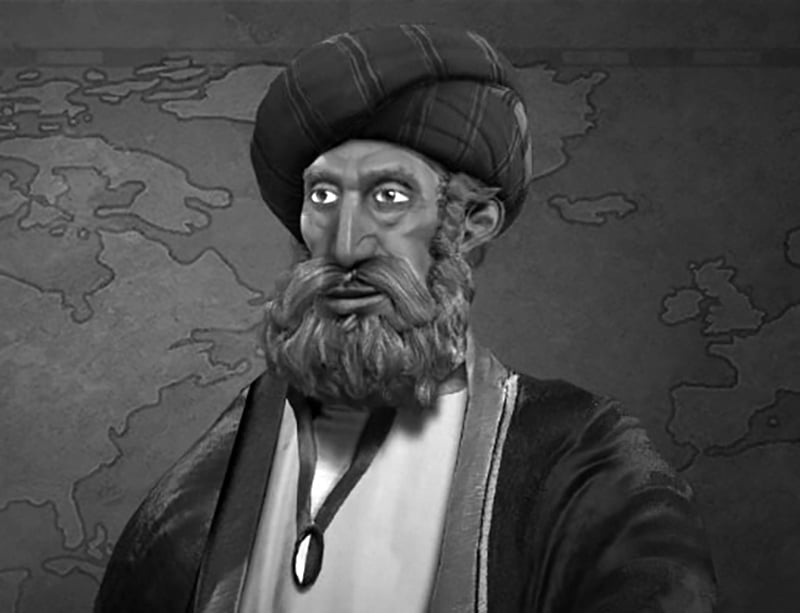
Al-Hassan ibn Suleiman son of Ali Al-Hassan ibn Suleiman son of Ali (also known as Hocen Soleiman, the late Dawud’s nephew) –enthroned by Persian colonists following uprising opposing Changa puppet, was a monarch for 16 years (1005-07)
- Ali son of Dawud I who ruled for 60 years was a son of Dawud, and al-Hassan’s nephew) (1023?)
- Ali son of Dawud II (Ali ibn Dawud’s grandson) whose 6-year reign was full of terror until he was deposed by the Kilwans and condemned to death. (1083)
- Al-Hassan son of Dawud also known as Hacen ben Daut was Ali ibn Dawud II’s brother who was a monarch for 24 years – the Kilwans elevated him to replace his hated brother. (1106)
- Suleiman from the royal lineage was deposed and decapitated by the Kilwans after just two years. (1129)
- Dawud ibn Suleiman, whose father was the previous monarch developed his career and wealth in Sofala, he ruled for 40 years after being called back to Kilwa as his father’s replacement. (1131)
- Suleiman son of al-Hassan ibn Dawud also known as Suleiman Hacen was the 9th son of the sultan above,(among the greatest sultans of Kilwa) recognized for capturing most of the Swahili Coast during his 18-year rule, annexing Pemba, Sofala, Zanzibar, and parts of the mainland ruled by Kilwa; credited for constructing various buildings in Kilwa, including the palaces and stone fortress, changing the town into a true metropolis. (1170)
- Dawud ibn Suleiman whose father was the previous monarch), and his reign lasted 2 years. (1189)
- Talut ibn Suleiman, a brother to the previous monarch whose reign lasted a year. (1190)
- Hussein ibn Suleiman, a brother to the previous monarch whose reign lasted 25 years and died without any heir. (1191)
- Khalid ibn Suleiman also known as Hale Bonij, was a brother to the previous monarch whose reign lasted 10 years. (1215)
- Ibn Suleiman, also known as Bone Suleiman, was a nephew of a former ruler, his reign lasted 40 years. (1225)
- Ali ibn Dawud whose lineage was uncertain but ruled for 14 years (1263–1267)
- 1277 marked an end to the Persian Shirazi dynasty and the start of Mahdali dynasty Sayyids (Yemeni Arab), or the ‘family of Abu al-Mawahib” according to the Zanzibar Chronicle.
Mahdali Period
- Al-Hassan ibn Talut, Ali ibn Dawud’s grandson captured power and ruled for18 years with a reputation of being “an excellent knight”. (1277)
- Suleiman ibn Hassan, a son of the previous monarch whore reign lasted 14 years although murdered by conspirators while coming from a mosque. Supporters enthroned Hassan ibn Suleiman as the monarch, however, his brother Dawud temporarily usurped his throne as Hassan was in Mecca on pilgrimage (1294)
- Daud ibn Suleiman whose father was the previous monarch – ruled for 2 years under his brothers’ Hassan. He voluntarily stepped down when Hassan returned from Mecca. (1308)
- Abu al-Mawahib al-Hasan son of Sulaiman whose brother was the previous monarch – who had taken over his power earlier while on pilgrimage in Mecca; ruled for 24 years and died without an heir. (1310)
- Dawud ibn Suleiman was a brother to the previous monarch and this was his second time to rule although, this time not sitting in for another. His reign lasted 24 years. (1333)
- Suleiman ibn Dawud whose father was the previous monarch and this was his first time on the throne, his rule lasted only 20 days. His Uncle Hussein al-Ma’tun deposed him, (1356)
- Hussein son of Suleiman al-Mat’un, an uncle of the previous monarch ruled for 6 years. He died fighting the “Almuli”, the Bantu people on the mainland without an heir. (1356)
- Talut ibn Dawud, a nephew of the previous monarch and a brother of Suleiman who ruled earlier – ruled for just one year. His brother Suleiman, the ex-monarch overthrew him. (1362)
- Suleiman ibn Dawud, a brother of the previous monarch, ruled for 2 years and 4 months during his 2nd reign –.his uncle Suleiman deposed him. (1364)
- Suleiman son of Suleiman ibn Hussein, an uncle of the previous monarch ruled for 24 years. (1366)
- Hussein son of Suleiman, a son of the previous monarch ruled for 24 years. (1389)
- Muhammad son of Suleiman al-Adil also known as al-Malik al-Adil or Mahamed Ladil a brother of the previous monarch ruled for 9 years. (1412)
- Suleiman ibn Muhammad, a son of the previous, ruled for 22 years. He died without an heir. And, he is credited for rebuilding Kilwa Mosque. (1421)
- Ismail ibn Hussein an uncle of the previous monarch– ruled for 14 years. His rule was challenged by Sa’id ibn Hassan – a pretender, who got Hassan son of Abu Bakr’s support, (monarch in Zanzibar). The people of Zanzibar formed a coalition to grab Kilwa forcefully. However, Ismail’s ministers, Emir Muhammad and vizier Suleiman bribed the main planner of the revolt, retreated the Zanzibari troops to leave pretender Sa’id stuck on Kilwa beach with just a handful of attendants. Despite Ismail pardoning him, Sa’id went underground. (1442)
- Vizier Suleiman (former vizier). After the death of Sultan Ismail, during the first known coupe by ministers, Emir Muhammad al-Mazlum and the vizier Suleiman launched a revolt and grabbed power together, consequently Suleiman pronounced himself sultan. Nevertheless, public opinion was strongly not in favor of the vizier, thereby he made up his mind to enthrone Emir Muhammad who was more popular. (1454)
- Muhammad son of Al-Hussein son of Muhammad son of Suleiman al-Mazlum also known as Emir Muhammad’ was a noble co-conspirator with the past monarch. The Zanzibar Chronicle revealed that after vizier Suleiman’s death, Muhammad pronounced Sa’id ibn Hassan, the old pretender, as his vizier. Muhammad passed on shortly after ruling for less than 12 months (To Barros, he was deposed). (1454)
- Ahmad ibn Suleiman who was the late vizier’s son was deposed in a year by supporters of the old monarchy. (Barros removes Ahmad, says the supporters directly deposed Muhammad.) (1455)
- Al-Hassan ibn Ismail, a son of the 32nd Sultan Ismail gained power through a coup and ruled for 10 years. (1456)
- Sa’id ibn al-Hassan or Hussein, a son of the former monarch, basing on Barros; same pretender (cf. 32nd) basing on Zanzibar chronicle) – was a monarch for 10 years. After his death, the Sultanate of Kilwa fell into chaos. Another ministerial coup happened. (1466)
- Suleiman son of Muhammad son of al-Husayn also known as ‘Vizier Suleiman’ seized the throne upon the death of Sa’id, proclaimed himself sultan as well as elevated Muhammad Kiwabi, his brother, to the emir. However, the reign of vizier-turned-sultan Suleiman lasted just over a year. (1476)
- Abdullah son of al-Hassan (a brother of 37th sultan, Sa’id) promoted by Kilwans against overthrowing vizier Suleiman. His reign lasted 18 months. (1477)
- Ali, son Hassan, a brother of the former monarch ruled for 17 months. After his demise, Emir Muhammad Kiwabi who was a brother of the deceased vizier Suleiman grabbed power and proclaimed al-Hassan, his nephew as sultan. (1478)
- Al-Hassan ibn Suleiman (vizier Suleiman’s son), was installed by Emir Muhammad, his uncle for the first time. However, al-Hassan turned out to be an unpopular sultan to be deposed by his uncle 6 years later (1479)
- Sabhat son of Muhammad son of Suleiman (‘Xumbo’, a descendant of royal lineage, whose father was al-Adil 31st sultan,) was enthroned by Emir Muhammad, following popular resistance regarding his preference al-Hassan. He died after ruling for a year. The Zanzibar Chronicle revealed, Emir Muhammad attempted to enthrone his nephew al-Hassan once more. (1485)
- Al-Hassan son of Suleiman (second time) was enthroned y Emir Muhammad by his uncle for the second time, however, popular resistance proved intense. Emir Muhammad opted to overthrow Al-Hassan again as well as search for an ideal replacement from the royal family. (1486)
- Ibrahim son of Muhammad (Sabhat’s brother, Al-Adil’s other son) enthroned by Emir Muhammad as a replacement for his nephew al-Hassan. However al-Hassan son of Suleiman after his overthrow launched an attempt to overthrow Ibrahim, this led to some bloodshed. Subsequently, al-Hassan’s dream was thwarted by Emir Muhammad, his uncle, who, trying to restore peace, proclaimed explicitly that Ibrahim, with royal blood, had superiority over al-Hassan, who was just from a viziers’ Al-Hassan was exiled on the mainland. Ibrahim’s reign lasted for two years until he was deposed by Emir Muhammad. (1490)
- Muhammad son of Kiwab (also known as ‘Emir Muhammad Kiwabi’, a powerful emir) proclaimed himself sultan, but for a brief period, perhaps just to show his ability or to fulfill his curiosity or probably only to launch a new bid by al-Hassan his exiled nephew in the meantime as he evaluated other candidates. Just in case, Muhammad left the throne soon after, enthroned al-Fudail, another member of a royal family member. (1495)
- Al-Fudail son of Suleiman (also known as ‘Alfudail’, Ibrahim’s nephew, having royal lineage) was enthroned by Emir Muhammad, following his abdication in1495 AD (901 AH). Soon after taking power, ex-monarch Hassan son of Suleiman returned from exile with a combined army of Kilwans and Bantu exilees to get back the throne. A Zanzibari Sheikh volunteered to mediate, and, using his good position, al-Fudail even considered relinquishing the crown to Hassan thereby ending the quarrel. (1495)
- However, Emir Muhammad rejected this. Alternatively, he promised al-Hassan forgiveness, on condition he went back to a quiet life in Kilwa. Whilst waiting for Hassan to respond to this offer, Emir Muhammad Kiwabi the great died rather suddenly. Amidst the confusion, Hassan the pretender sneaked troops into the city, commanded by his son Sa’id. Captured by the city administration, Sa’id made up a story about only ‘preparing the house’ so his father can have a peaceful return to the city as a regular citizen. To avoid suspicions, Sa’id, at last, suggested leading a delegation from Kilwa, escorted by a group of city soldiers, to his father’s camping ground to verify his story. Believing the issue had been subdued, somewhat until the delegation came back from its inquiry, Kilwa became less vigilant. However, the delegation didn’t return. Instead, Sa’id lured it into a trap, and it was murdered. Al-Hassan’s army attacked that night. The city caught off-guard, gathered desperately to its defense, leading to a murderous battle that started outside the city gates afterward. The Kilwans crushed al-Hassan and stopped the perpetual pretender. The triumphant Sultan al-Fudail nominated a one Ibrahim son of Suleiman as emir, replacing Emir Muhammad who had died. However, this condition just stayed a few years.
Fall of Mahdali dynasty c. 1495, the start of a sequence of Portuguese puppets and usurpers.
Portuguese Period
- Ibrahim son of Suleiman (also known as ‘Emir Ibrahim’, or ‘Mir Habraemo’ in Portuguese) was Sultan al-Fudail’s minister who overthrew and killed the sultan and captured power not as sultan, simply acting on behalf of an absentee son of Suleiman, an earlier sultan. Outraged, the regional subordinates of the sultan of Kilwa rejected acknowledging the usurpation. Francisco de Almeida, a Portuguese captain drove out and deposed Emir Ibrahim in 1505. (1499)
- Muhammad son of Rukn ad-Din (known to the Portuguese as Muhammad ‘Arcone’, a Kilwan noble without royal lineage) enthroned by Francisco de Almeida to become a Portuguese subordinate sultan of Kilwa. However, remembering the significance of upholding the constitution, Muhammad soon ordained royal prince Muntari, late al-Fudail’s son, as his successor. After a year, he was assassinated. (1505)
- Micante (1506)
Potential Link to Australia
By 1944, 9 coins were discovered on Marchinbar Island, the biggest island among the Wessel Islands in Australia’s Northern Territory. Although 4 coins were recognized as Dutch duits from 1690 to 1780s, 5 having Arabic markings were recognized as coming from the sultanate of Kilwa. The coins are today found in Sydney’s Powerhouse Museum, Australia. By 2018, another coin believed to originate from Kilwa too was discovered on Elcho Island beach, also part of the Wessel Islands.
For more articles about Tanganyika click here!

























